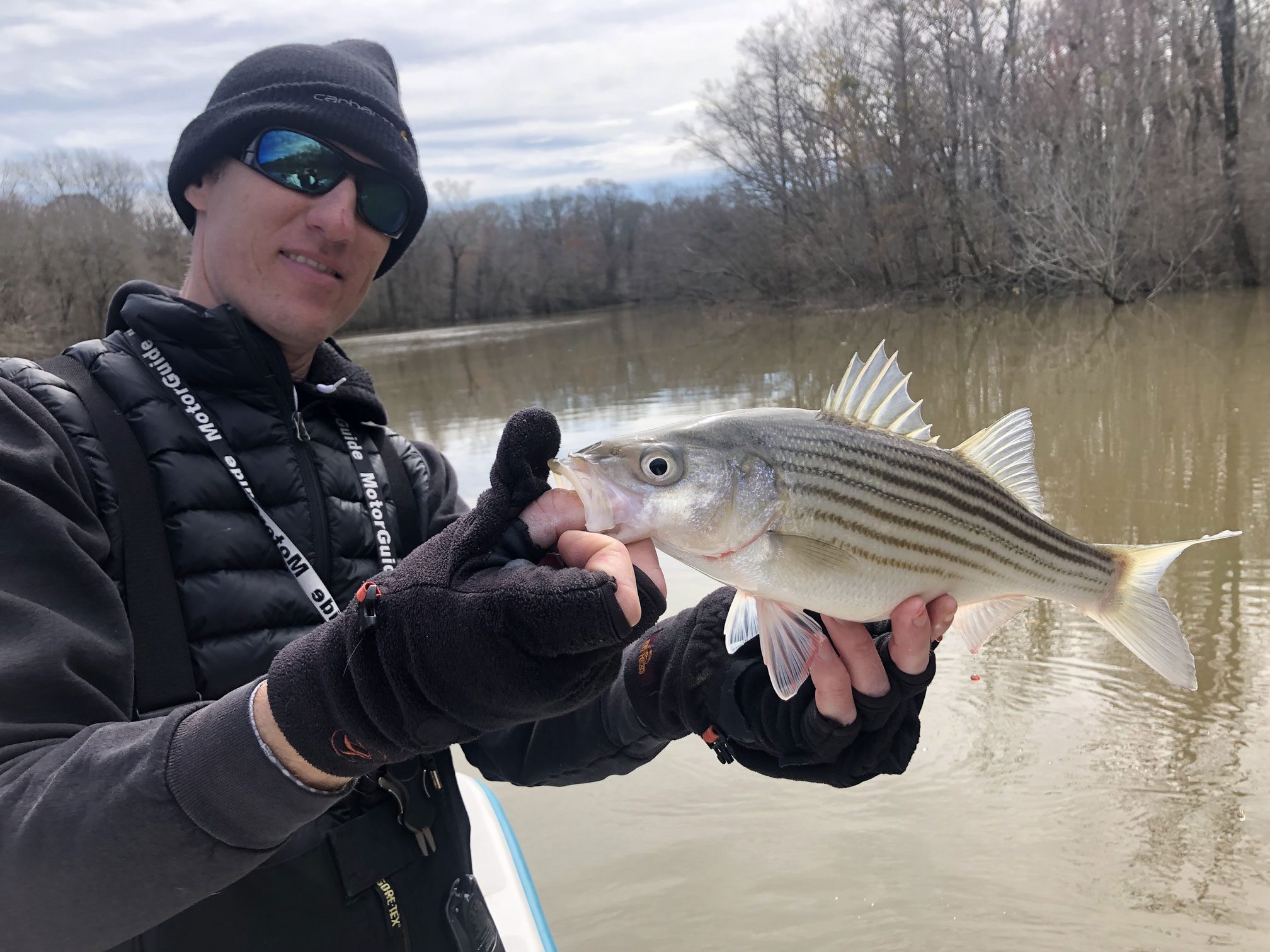Tidelines – March 21, 2019
Striper closures are making news so far in 2019, but on the lower Roanoke River, thanks to Capt. Mitchell Blake of FishIBX Charters, we were not only able to get on good bite, but also able to bring a few fish home for dinner.
Rocky (Fish Post writer) and I met Mitchell at the Williamston boat ramp, just a little bit north of Washington, and after a quick run upriver to check out some “bleeds,” Mitchell handed us each a rod with a 3/8 oz. jig head with a custom soft plastic that he and his sons had poured themselves.
These “bleeds” are areas where the water is flowing out of the swamps. He likes to target these bleeds, rather than feeder creek mouths or main channels, as they seem to offer a more attractive relief zone from the river’s main current.
Mitchell pointed out an area that had good bubbles running out, and he told us to not just cast to the bubbles, but look for bubbles that aren’t flowing. These bubbles that are holding tight alongside the flowing bubbles, he continued, are small eddies, and these small eddies are usually good for one or two fish each.
“If you’re not seeing bubbles, look for pollen floating or sticks floating,” he continued, turning off the big engine and putting down the trolling motor to hold our position.
The jigs we were throwing were tied directly to 20 lb. braid. The reason for no leader and a straight braid connection, he explained, was simple, “It’s nothing but a function of saving tackle. A pack in, pack out mentality. You want to take your jigs back home with you.”
Yes, snags are a regular occurrence when river fishing for stripers. Our goal was to keep the jig maintaining contact with the bottom as we cast up close to the tree line and then bounced the jigs back all the way to the boat. The typical winter jig action isn’t emphasized, but rather a more subtle effort.

Capt. Mitchell Blake, of FishIBX Charters, with one of the several stripers pulled up from around fallen trees that had accumulated on a bend in the lower Roanoke River. He was bouncing 1/2 oz. jig heads and custom soft plastics off the river’s bottom.
Mitchell had been whacking the stripers all winter long, but as it sometimes goes when you put the Fish Post crew on the boat to do an article, the stripers weren’t active on the first two bleeds we targeted. Speculation went to the extremely cold nights of sub-30 degree temperatures we were having. Though it was steadily warming up on our morning, Rocky and I had seen nothing but 26-28 degree temperature readings on the drive from Wilmington that morning.
All three of us had had a few bumps but no hook sets, so we moved to a color change, another feature that Mitchell likes to target.
Since the region had barely seen any rain, the color changes in the river were due to either two different water temps or two different pH levels. Before we sent out a couple of casts at our new location, though, Mitchell wanted to change out our jigs to something a little heavier.
There was a strong current thanks to upriver dam releases, and with the light bite that we were apparently experiencing, it became even more important to maintain contact on the bottom. To that end, Mitchell swapped out the 3/8 oz. jig heads for 1/2 oz.
“If you don’t have constant connection with the bottom,” he reiterated, “then you’ll never feel that light bite that we’re getting today. These 1/2 oz. jig heads will help us get down a little bit faster and a little bit deeper.”
Our second spot produced a couple of fish, but it still wasn’t the “hot striper bite” you expect on the Roanoke, so we moved downriver to try the inside of a big bend.
Mitchell especially liked this bend because it came after a long, straight stretch, and the thought was that the stripers would be looking for a break in the current flow by the time they got to the turn. This corner would also be a rest and holding area for the blueback and alewife herring, the main food source for these winter stripers.
We cast out among the fallen logs that had accumulated, and this time the bites were instant.
All three of us started to regularly hook stripers ranging in size from a little bit over 18” to a little under, but still the bite was a light one. Each of us would first feel a bump, and then maybe another bump or two, before finally being able to set the hook.
We culled a few of the bigger fish in the livewell, each of us with plans for a striper dinner that evening, and when the “bite window” eventually slowed down, Mitchell put us back in the direction of the boat ramp and started talking about “fishing spots.”
“I’m not really fishing regular spots,” he noted. “I’m looking each day for what the river has to offer. I’m reading water and looking for the bleeds, the color changes, the ledges. It’s about finding new places where the fish will tuck in, hide, rest, and feed, as it changes constantly with the changing river levels.”

Capt. Mitchell Blake (left), of FishIBX Charters, and Gary Hurley, of Fisherman’s Post, with one of their double striper hookups on the lower Roanoke River. They were fishing out of the Williamston boat ramp.
“I had a client ask me what I do when the people find out my spots, and I told him that next week or even tomorrow, those spots might not be spots anymore.”
Capt. Mitchell Blake, of FishIBX Charters, will be catching big numbers of stripers on the Roanoke River through April, when the keeper season ends (two stripers between 18-22”, or one over 27” and one between 18-22” through April). After April the fishery turns to all catch and release, but he’s still putting together striper trips where 100-fish days can be common.
If you’re looking to come out of winter and feel the strike and pull of quality fish, then give Mitchell a call at (252) 495-1803, or visit him online at www.fishibx.com.
My guess is that those 30-degree nights are now behind us and the spring weather trend will continue, making for an enjoyable day on the Roanoke (or on the Pamlico, where Mitchell likes to target a bigger class of fish).
And, of course, you should send us a photo. Our next issue, the April 11 issue, is just around the corner, or maybe I should say our next issue is just ahead on a big bend in the river.





